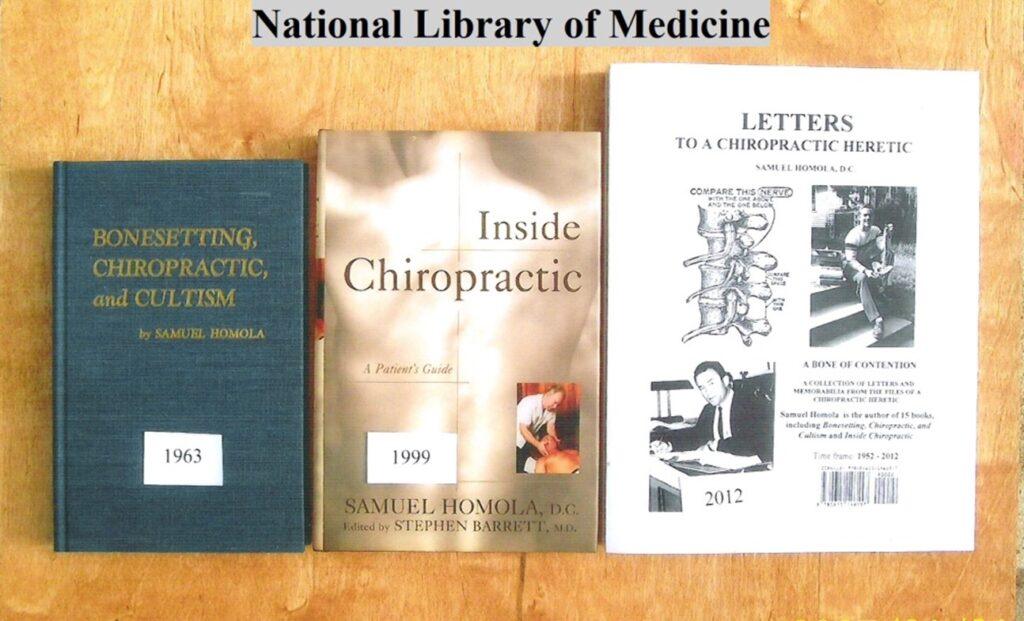My father was a chiropractor who graduated from the Palmer School of Chiropractic in Davenport, Iowa, in 1920. In 1952, I enrolled as a student at Lincoln Chiropractic College in Indianapolis, Indiana. Chiropractic was based on a theory formulated in 1895 by D.D. Palmer, a magnetic healer who claimed that 95 percent of diseases were caused by vertebral subluxations, treated by manipulating the spine. After a few semesters of mixing basic science study with chiropractic philosophy, it became apparent to me that Palmer’s subluxation theory was a tenuous belief, not supported by the laws of anatomy and physiology.
In 1963, I renounced the chiropractic subluxation theory with the publication of my book Bonesetting, Chiropractic and Cultism. In the years to follow, unable to find any credible evidence to support subluxation theory, I limited my practice to treatment of musculoskeletal problems, primarily back pain, combining use of spinal manipulation with physical therapy modalities. I continued to express my views as a critic of vertebral subluxation theory in order to protect public health and to promote development of chiropractic as a conservative musculoskeletal specialty. I stood alone in the chiropractic community, labeled as an enemy of the chiropractic profession. In fear of ad hominem attacks from subluxation-based chiropractors, who were in the majority, few chiropractors would express concern about the validity of chiropractic subluxation theory.
Subluxation Theory: A Global Consensus
On September 14-15, 2019, in Toronto, Canada, 50 researchers from 8 countries and 28 observers from 18 chiropractic organizations met in a Global Summit to determine the efficacy and effectiveness of spinal manipulative therapy for the primary, secondary, and tertiary prevention of non-musculoskeletal disorders. The conclusion of their systematic review of the literature did not support the vertebral subluxation theory:
We found no evidence of an effect of SMT [Spinal Manipulative Therapy] for management of non-musculoskeletal disorders, including infantile colic, childhood asthma, hypertension, primary dysmenorrheal, or migraine. This finding challenges the validity of the theory that treating spinal dysfunctions with SMT has a physiological effect on organs and their function. Governments, payers, regulators, educators, and clinicians should consider this evidence when developing policies about the use and reimbursement of SMT for non-musculoskeletal disorders. (Chiropractic and Manual Therapies, February 17, 2021)
Where have we heard this before?
This conclusion echoes the 2009 groundbreaking review “An epidemiological examination of the subluxation construct using Hill’s criteria of causation“. The treatise, authored by Timothy Mirtz, DC, PhD, et al, concluded:
There is a significant lack of evidence in the literature to fulfill Hill’s Criteria of Causation with regards to the chiropractic subluxation being associated with any disease process or creating sub-optimal health conditions requiring intervention. Regardless of popular appeal this leaves the subluxation constrict in the realm of unsupportable speculation. This lack of supportable evidence suggests that the subluxation construct has no valid applicability. (Chiropractic and Osteopathy, December 2009)
Vindication
These reports provide support for views I have been expressing since 1963.

In 2023, I was nominated for the international John Maddox Prize for my stand on the side of science as an embattled critic of the scientifically indefensible vertebral subluxation theory. I did not win the prize, but my nomination was an acknowledgement of my published work as a worthwhile contribution to the literature.
The profession today
Today, the chiropractic profession is divided internally by subluxation believers and subluxation deniers. Although some chiropractic colleges have backed away from subluxation theory, few have openly renounced the theory. Most state laws continue to define chiropractic as a subluxation-based profession. Properly limited chiropractors who treat musculoskeletal problems must continue to compete with subluxation-based chiropractors who embrace a broad scope of practice as a form of alternative medicine.
Like homeopathy, osteopathy, and other disciplines given birth by a belief system, factions of subluxation believers in chiropractic will persist since true believers are not subject to critical thinking or scientific analysis.





